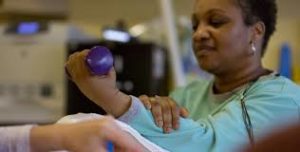Tips for Hand and Arm Exercises after a Stroke.
NeuroRehab Team
Monday, July 11th, 2016

Amit Kumar, Occupational Therapist, LS Life Skills Therapy Services Inc., Surrey, BC
Every stroke survivor’s impairment is unique. By doing regular functional activities and exercises, you can increase your quality of movement and independence in all stages following stroke. Activity may be too easy or too hard depending on the extent of impairment and function. Your occupational therapist can help you develop a daily activity and exercise program appropriate for you. Activities and exercises to improve your hand function should be simple and done at home at any time.
Top 10 Hand and Arm Stroke Exercise Tips:
1. You are unique
Every survivor is unique. Your experiences; values; lifestyle and environment are different from others. Therefore, it is important to set realistic goals based on what is important and meaningful to you.
2. Meaningful activity
Choose activities that are meaningful, interesting and taken from real life. If your goal is to improve your ability to hold walking cane then try using your affected hand’s finger around fridge’s door and drawer handles to improve your grip.
3. Inclusion not seclusion
Try to break and prevent from developing non-use cycle. When you include your affected arm in daily tasks, it leads to faster recovery and independence as sensory information is relayed to your brain. For e.g., carrying small shopping bags with your affected arm frees up your non affected arm so that you can use your walking aid. Put both forearms on the table when seated to improve your posture and activity participation.
4. Practice makes perfect
Frequent repetitions and practice will improve your skills. Polishing table with a towel using both upper extremities helps reduce spasticity and assists with improving range of motion. You can also try polishing and shining your car and/or apply butter on bread for yourself and family.
5. Do what you like
Choose an activity which is fun filled and something you like to do such as playing games, dancing, playing musical instruments, painting, or writing. Start you day with the activity you like. Do it on a regular basis at small intervals.
6. Home sweet home
Your home is the best place to do your exercises. There is evidence that better transfer of learning happens when exercises and activities are performed in your home environment. There is an endless possibility of using daily items in your home as treatment tools such as staircases, countertops in the kitchen and washrooms, chairs, beds, dining table, bookshelves, storage cabinets etc.
7. Surface, surface, surface
I am a big fan of using surface as a tool. Surface can be stable or movable. It can move down and up; left and right; or near and far. If you currently have low arm function, keeping your affected hand stable on the table and trying to reach out to pick up a glass of water with your unaffected hand helps activate your affected hand. If you have a high level of arm function, then try to use movable surfaces such as a therapy ball and/or a side table with wheels to increase your skills. Reaching overhead to pick up food cans helps improve upper extremity function and flexibility. A therapist can assist and guide you with appropriate surface selection based on your level of function.
8. Sleep! Sound Sleep!
Research suggests that sleeping throughout the night is another way to consolidate learning. This also helps us to begin our day with more energy, patience, and attention.
9. Movement and exercise
When you move your body, brain cells reorganize. Movement is closely related to exercise. It is an ice breaker. Therefore, grab the opportunity and initiate any chance of moving your affected side. Participate in group exercise programs, games, or sports to wake up sluggish bodies and brain. Just six months of exercise can improve memory, language, thinking and judgment problems by almost 50 per cent, says a study presented at the Canadian Stroke Congress. You should aim to do at least 30 minutes of moderate physical activity five or more times a week. You don’t have to do all 30 minutes at once. This can be broken up into smaller blocks of time throughout the day.
10. Reward yourself
We all work best when there is an incentive. It is much more likely we stay on schedule in achieving goals, and even sometimes we end up achieving sooner than expected if there is a reward. Set your goals and reward yourself when you reach them. This will keep you happy and motivated. Your goal could be anything from sticking to your exercise schedule to walking further or even if it’s just a twitch in your fingers.

